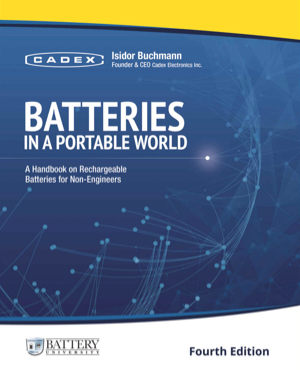Welcome to the Leaning Tools section of BatteryUniversity.com. Here you find practical experience and gossip from many conferences and academic institutions summarized in entertaining and easy-to-read presentations. Guys don’t want to read too much, so enjoy the engaging graphics as teaching tool.
Basics about Batteries
Lean about the advantages and disadvantages of different battery chemistries, packaging and configurations, charging and discharging, safety and health concerns, as well as transporting and storing them. The presentation also advises what batteries like and dislike and how you can prolong their lives.
55 slides PowerPoint
- Cover
- Outline
- Battery Chemistries
- Relationship between Power and Energy
- Energy storage capacity
- Ability to deliver current
- Battery chemistries - Lead Acid
- Types of Lead Acid Batteries
- Nickel-cadmium (NiCd) & Nickel-metal-hydride (NiMH)
- Types of Lithium Batteries
- Li-ion Systems
- Lithium-polymer Hype
- Confusion with Nominal Voltages
- Safety concerns with Li-ion
- Packaging and Configurations
- Battery formats
- Cylindrical cell
- Button cell
- Prismatic cell
- Pouch cell
- Best Cell Design
- Serial connection
- Parallel connection
- Serial-parallel connection
- Charging, Discharging, Storing
- The right way to charge lead acid
- The right way to charge NiMH
- The right way to charge Li-ion
- What batteries like and dislike
- Charging / Discharging
- Ultra-fast charging
- Charging without wires
- Charging without wires cont.
- Charging at high and low temperatures
- Charging from a USB Port
- Discharge methods
- Storing
- Health concerns with lead
- Health concerns with cadmium
- Transporting Li-ion
- Transporting Li-ion cont.
- FAQ on charging and discharging
- How to prolong Battery Life
- Battery fade cannot be stopped, but slowed
- Knowing the difference between Capacity and SoC
- Avoid deep discharges
- Keep battery cool
- Retain moderate charge voltage
- Tables of Battery Dos and Don’ts
- Summary
- What people say
- Limitations with Current Technologies
- How far can the Battery go?
- Net Calorific Values
- Take home
Download Basics about Batteries 10.0mb

Looking for comments from the previous website?
Comments from the previous website are not compatible with our new commenting system but we have preserved them so our users can still reference and make use the information in them.

hi battery experts,
I am battery ignorant but did build diy series dc motor to my
grandson. I cannot start it with my 50 v li-ion battery because winding
wire is so thick that calculated short inrush current exceeds max discharge current 40 amps
of battery. 2 solutions in my mind:
(1)
I did figure out to use 3 pieces 12v amg batteries in series ( mtx 6ah, CA 107 amps).
What happens if I connect this to motor and inrush current for some tens of
millisecond is 130 amps and drops very fast?
Does batteries explore or give this 107 amps?
(2)
An other idea:
I make 3 input pins, first i connect one battery and inrush current is some 60 amps,
then when back emf developed I connect 2 in series finally 3.
Does this seem a possible solution?
Many thanks to enlight me!